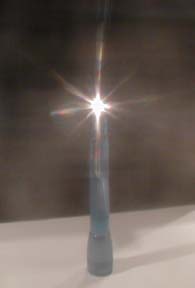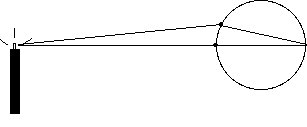Believe half of what you see

Rays extending from the bare minimaglite bulb.
How this photo was
made.
Believe half of what you see

Rays extending from the bare minimaglite bulb.
How this photo was
made.
Introduction
A bright point of light will appear to be
surrounded by a spray of rays of light.
Locating these rays is an exercise in inquiry and the scientific
method.
Material
A Minimaglite flashlight
a 3 x 5 index card (Optiona,l and better, a black card about the size of a 3x5 index card)
Assembly
Completely unscrew and remove the front of a
minimaglite.
The light will come on as a bright point.
To Do and Notice
Observe the point of light in a dim or dark room.

What do you see?
Notice that it is surrounded by a spray of radial light rays.
Locate the rays.
Now you may say, "What a silly assignment! the
rays are obviously located around the light. "OK then, prove to me
that they are located around the light.
That is, devise an experiment to convince someone else.
If you need some suggestions in your attempts to locate the rays, read on. Here are experiments devised by fellow participants in the Institute.
Rotate the minimaglite, what do you notice about the rays?
Notice that the rays do not rotate.
Rotate your head. What do the rays do?
Notice that the rays do rotate.
If you wear glasses remove them.
Notice that the rays remain in focus even though the body of the flashlight goes out of focus.
Hold the 3x5 card between your eyes and the light.
Try to block the rays without blocking the light.
Notice that even if you hold the card very close to your eyes the rays are always between the card and your eyes.

Look at the light over the top of a 3x5 card
Block the filament with the thin tip of a pencil or pen.
Notice that the rays vanish.
What's Going On?
The rays of light are not around the light at all.
They are produced inside your eyeball on your retina by diffraction.
Optical imperfections in your cornea and lens will diffract the light from the point of light into straight lines.(To make lines the imperfections themselves must be linear.)
The rays actually exist on your retina, yet your brain incorrectly perceives that the rays exist in space radiating from, and at the same distance as, the lamp.
So What
Have you ever been swimming for a long time and then looked at a small bright light, like a bare lightbulb or a candle? Did you notice that that it was surrounded by circles of colored light. These colored light circles are also caused by diffraction from imperfections in your cornea, these temporary imperfections are as small as a wavelength of light and more circular than linear. They are called "lakes" and are tiny regions of fresh water that have moved into your cornea. As the water goes away the colored light rings disappear.
Etc
If the scratches are randomly placed why are the rays radial?
Consider a point on your cornea located on a straight line between the lamp and the center of your retina. Scratches go through this point in all directions. A scratch will produce a line of light perpendicular to itself. So the scratches produce lines of light radiating in all directions around this central spot.
Next consider a point on the cornea off to one side. A ray of light from the lamp to this point is bent by the cornea and lens and imaged at the same point as the first ray we considered. So that all the scratches which go through this point produce radial streaks of light by diffraction which radiate out from the image of the bulb. Thus every scratch on the cornea regardless of its location produces a ray which radiates out from the image of the bulb.

We photographed the minimaglite through a piece of plastic which had been lightly scratched with sandpaper. The sandpaper scratches were made in several directions.
Scientific Explorations
with Paul Doherty 19 May 2000